Criminal court statistics quarterly: July to September 2020
Published 17 December 2020
Applies to England and Wales
We are trialling the publication of this statistical bulletin in HTML form at alongside the usual PDF version and we are seeking user feedback on the use of HTML for the publication of statistical bulletins. Please send any comments to: datausers@justice.gov.uk.
Main Points
| COVID-19 and associated actions impacted on most criminal court measures | The recovery at the criminal courts continued following the initial impacts of the COVID-19 response. Guidance related to the COVID-19 pandemic affects many of the criminal measures in this bulletin. |
| Magistrates’ court: sharp rise in disposals | Receipts and disposals increased from series lows in Q2 2020, up 11% and 92% respectively, but remain below pre-COVID levels. Outstanding cases fell 2% but remain 43% higher than Q3 2019. |
| Crown Court: increase in receipts and disposals | In Q3 2020 receipts doubled and disposals increased by 65% compared to the previous quarter. |
| Crown Court: continued increase in outstanding cases | The volume of outstanding cases increased by 44% compared to the previous year and 19% on the previous quarter. |
| Crown Court: trial listings and vacations increased | In Q3 2020 there were 1,654 trials listed, a marked increase from 113 trials in Q2 2020 but well below Q3 2019 (6,249). Trial vacations continued to rise, up 3% on the previous quarter. |
| Timeliness at both magistrates’ court and Crown Court increased | The time from offence to completion at the magistrates’ court increased by 25% on the previous year. At the Crown Court, the time from receipt to completion increased by 20% over the same period. |
| Enforcement: Financial impositions increased | Total financial impositions increased on series lows in Q2 2020, but remain well below pre-COVID levels. The value of outstanding financial impositions remained at £1.2 billion. |
| Interpreters: completed requests increased | The number of completed requests in Q3 2020 (33,143) increased from a series low in the previous quarter (6,775) and the success rate remained stable (98%). |
The technical guide to ‘Criminal court statistics’ and ‘Language interpreter and translation services in courts and tribunals’ can be found at the links below:
https://www.gov.uk/government/publications/a-guide-to-criminal-court-statistics
https://www.gov.uk/government/statistics/guide-to-language-interpreter-and-translation-services
Statistician’s comment
“This report covers the period to the end of September 2020 and shows the continued impact of COVID-19 on criminal courts.
Following the limited operation of the criminal courts [footnote 1] and the gradual reintroduction of jury trials [footnote 2] during the report period, the figures published today show signs of recovery in the system. This can be more clearly seen at the magistrates’ courts, where disposals have risen sharply in the latest quarter though are still below pre-COVID levels. A higher volume of disposals than receipts in the latest period has meant that the outstanding caseload has fallen.
Some of the magistrates’ court disposals will feed directly through to the Crown Court, where receipts have doubled in the latest quarter. Disposals have also increased but not at the same rate as receipts, as a result the outstanding caseload has risen.
The trends at both magistrates’ courts and the Crown Court continue beyond the National Statistics series into more recent management information published by Her Majesty’s Courts and Tribunal Service (HMCTS) – which are highlighted in this document.”
1. Change to note
COVID-19 and future publications
The COVID-19 pandemic has caused MoJ to have to change its data gathering, access and release practices, focusing efforts on priority analysis and statistics. Our statement explains this further. Of particular note, we temporarily paused access to the Police National Computer earlier this year, to minimise non-essential travel by our analysts. Whilst access has resumed now, work is being resumed on a prioritised basis.
As a result, and in line with guidance from the Office for Statistics Regulation, the decision has been made to delay the publication of all linked end-to-end criminal court timeliness data in this publication. We will keep users updated of any further changes via our published release calendar. Separate (‘unlinked’) timeliness estimates for cases completing at the magistrates’ courts and Crown Courts respectively have been included in this release.
Common Platform and reform to criminal court data
The ‘Common Platform’ [footnote 3] is a new digital case management system for the magistrates’ and Crown Courts. The system seeks to streamline data collection, data accessibility and improve the way criminal cases are processed across the Criminal Justice System. It will eventually replace the existing ‘legacy’ criminal court systems Libra (magistrates’) and XHIBIT (Crown), with a single, streamlined system.
Early adopter courts across England and Wales will test the system before the subsequent rollout to all criminal courts. Derby magistrates’ and Crown Court began this process in September.
-
Data for the magistrates’ court caseload does include both ‘legacy’ and Common Platform data for Derbyshire as new cases enter the new system.
-
Crown Court measures and all timeliness data do not include all of the Common Platform data. The omitted data represents a small number of cases and does not impact any published trends in the current release.
Work is ongoing with HMCTS and partner agencies to better understand the implications this system change has for the published National Statistics series and their underlying methodologies. We are committed to ensuring that published statistics remain accurate, robust and coherent for users during the operational transition of data systems at the criminal courts.
Data developments
Timeliness estimates for 2020
As highlighted above, due to the COVID-19 pandemic, it has not been possible to produce linked end-to-end criminal court timeliness estimates for Q1 and Q3 2020. Data to the end of December 2019 remains the latest available estimates.
We have sought to best meet user demands and have included separate (‘unlinked’) timeliness estimates for magistrates’ courts and Crown Court.
-
The magistrates’ court data replicates the existing timeliness data and we have been able to update tables T1 – T3 to give updated estimates of the time spent from offence to completion at the magistrates’ courts.
-
The Crown Court data is not directly comparable with the existing timeliness series and as such it is published as ‘experimental statistics’ while we develop a new linked timeliness series. The published data provide estimates of the average duration that defendants dealt with are spending at the Crown Court, e.g. from receipts to main hearing and from main hearing to completion.
We will continue to review arrangements and are developing an alternative methodology to calculating linked end-to-end timeliness and will keep users informed. We remain committed both to the wellbeing and safety of our staff, and to providing the best and most accurate information we can, serving the public good at a time when it is needed the most.
For further information regarding the extent and impacts of the data developments detailed here please see the Guide to criminal court statistics.
Failure to appear warrants
This is the fifth publication of a new series on Failure to Appear (FTA) warrants issued in magistrates’ courts. These are published as experimental statistics, developed alongside colleagues in Her Majesty’s Courts and Tribunal Service (HMCTS) in response to user demand and will be subject to further development, in line with users’ views.
Supporting guidance and further information relating to the FTA collection can be found at the link below: https://www.gov.uk/government/collections/criminal-court-statistics
Feedback is sought regarding the experimental FTA statistics and can be directed to: HMCTS_Analysis_and@Justice.gov.uk
2. Criminal cases in the magistrates’ courts
Criminal case receipts and disposals at the magistrates’ courts rose, while outstanding cases fell following a series peak in Q2 2020.
Receipts and disposals rose by 11% and 92% on the previous quarter, but remain around a third below levels seen in the previous year. Outstanding cases fell by 2% on the previous quarter as operational capacity increased but levels remain 43% higher than the previous year.
Figure 1: Magistrates’ courts caseload, Q2 2012 – Q3 2020 (Source: Table M1)
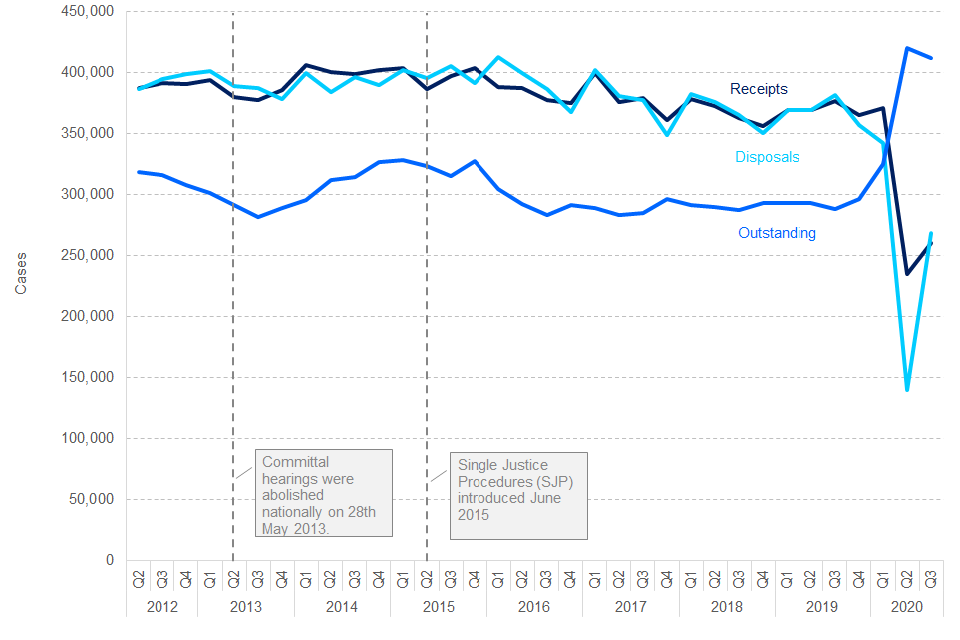
!!1
Magistrates’ court caseload
In Q3 2020 overall receipts and disposals rose from series lows in Q2 2020 after the phased reopening of courts [footnote 4]. However, levels remain well below that seen in the previous year following the review of court arrangements on the 23rd March 2020 [footnote 5].
-
Receipts increased by 11% compared to the previous quarter but remain 31% lower than the previous year. The fall over the year can be seen mostly in summary non-motoring (down 51%) and summary motoring cases (down 24%).
-
The volume of cases disposed of increased sharply on the previous quarter, up 92% from a series low of 139,563 to 268,338 in Q3 2020. Sharp increases can be seen across all case types, particularly for summary non-motoring cases which have increase by more than three times (from 21,715 to 68,331). Overall disposals remain 30% below levels seen in Q3 2019.
There were 412,093 outstanding cases at the magistrates’ court in Q3 2020. This represents a 2% fall on the series peak in Q2 2020 (420,459). The quarterly fall was seen across all case types except for summary motoring cases (up 4%). The levels in Q3 2020 represent an increase of 43% compared to the previous year (288,600 in Q3 2019). The annual increase is true across all case types, but the largest proportionate increase was seen in trial cases (up 59% on the previous year).
The latest published HMCTS management information provides weekly volumes of receipts, disposals and outstanding cases for all cases types at the magistrates’ courts (e.g. including civil and enforcement in addition to criminal cases).
Data to the week ending 22nd November 2020 shows that weekly receipts and disposals remain below pre-COVID baselines (down 35% and 25% respectively). However, both have tended to increase since mid-April, with disposals tending to be above receipts since the beginning of August. As such outstanding case volumes have continued to fall from a peak of 525,059 at the end of July to 479,489 at the week ending 22nd November 2020 – remaining 18% higher than a pre-COVID baseline of 407,129.
Trial efficiency
The total number of trials in magistrates’ courts sharply increased in Q3 2020 after reaching historical lows in Q2 2020.
There were 11,732 trials listed in Q3 2020, a six-fold increase from the series low in Q2 2020 (1,715) but this is down 58% on Q3 2019.
Of trials listed, the proportion that are ineffective has increased by 4 percentage points compared to previous quarter (from 15% to 19% in Q3 2020) and a corresponding decrease can be seen in the effective trail rate (from 49% to 44% in Q3 2020).
Vacated trials are trials which have been removed from the listing before the date of the trial, they are counted in the period the vacation happened rather than the date when they were due to be listed (e.g. as for effective, cracked and ineffective estimates). The number of vacated trials fell to a series low in Q3 2020 (4,465), down 66% from a series peak in Q2 2020 (13,208).
Figure 2: Magistrates’ courts vacated trials, Q1 2010 – Q3 2020 (Source: Table M2)
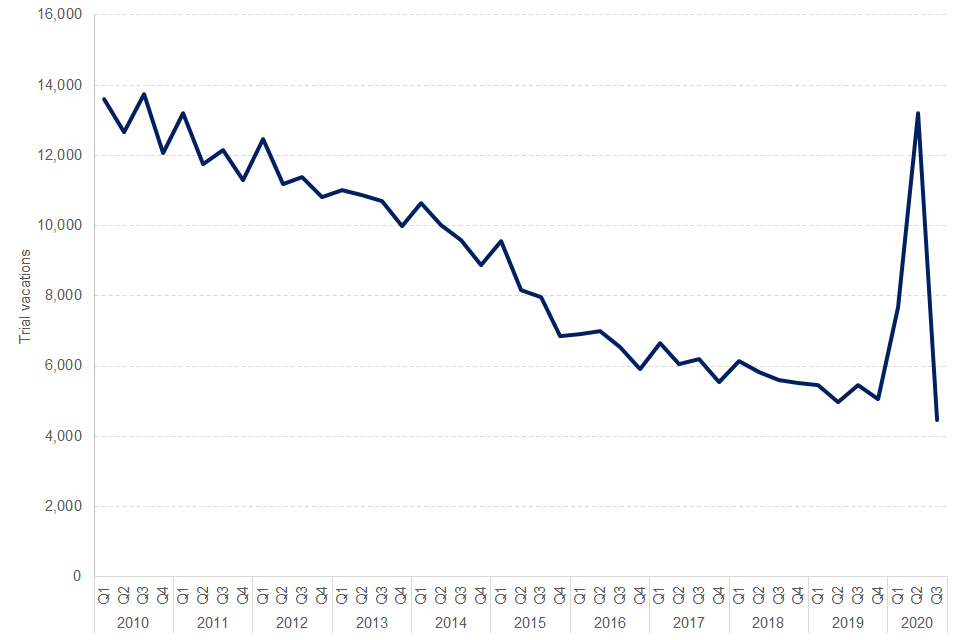
!!2
3. Criminal cases in the Crown Court
The volume of outstanding cases at the Crown Court continued to rise, while receipts and disposals both increased after low seen in Q2 2020.
In Q3 2020 receipts doubled and disposals increased by 65% compared to the previous quarter. The volume of outstanding cases increased by 44% compared to the previous year and 19% on the previous quarter.
Figure 3: Crown Court caseload, Q1 2014 – Q3 2020 (Source: Table C1)

!!3
Crown court caseload (Table C1)
The increased throughput from the magistrates’ courts following the ongoing recovery from COVID-19 response impacts has resulted in an increase in receipts at the Crown Court. Similarly, the phased reintroduction of jury trials [footnote 6] mean the operational capacity of the court estate has increased and subsequently disposals at the Crown Court have risen.
In Q3 2020, there has been an increase in both case receipts and disposals. The greater rise in receipts has led to the continued increase in outstanding case volumes.
-
The volume of case receipts into the Crown Court more than doubled from the previous quarter (14,241 to 28,497) and is 7% higher than the previous year. Trial receipts are well above pre-COVID levels (up 23% on the previous year), while both sentence and appeal case receipts fell (down 7% and 49% respectively)
-
Comparatively, there was a smaller 65% increase in disposals compared to Q2 2020, from 12,339 to 20,300. Despite the quarterly increase case disposals are 20% lower than the previous year, with annual falls seen across all case types.
At the end of Q3 2020 there were 50,918 outstanding cases at the Crown Court, an increase of 44% on Q3 2019 (35,478 cases). This is the highest level of outstanding cases seen since the end of 2015 and continues the consistent increases seen since Q1 2019.
-
The increase can be seen in ‘for trial’ and sentenced cases, which increased by 52% and 22% respectively compared to Q3 2019. Appeals against magistrates’ decisions saw a 3% fall in outstanding cases across the same period.
-
The increase in ‘for trial’ outstanding cases compared with the previous year can be seen across all offence groups to varying degrees. The largest proportional increases on the previous year were seen for drug offences (up 65%) and sexual offences (65%).
The latest published HMCTS management information provides weekly volumes of receipts, disposals and outstanding cases for all cases types at the Crown Court.
The data to the week ending 22nd November shows that weekly receipts have settled back to around pre-COVID levels following a peak at the start of October. Disposals started to increase back to near pre-COVID levels in the latest period. Receipts have tended to remain higher than disposals, causing outstanding case volumes to increase. There were 53,318 outstanding cases in the latest period, 36% higher than a pre-COVID baseline of 39,331.
Trial efficiency
The volume of trials at the Crown Court has tended to fall since 2015, from around 39,000 trials listed to 24,000 in 2019. In Q3 2020 there were 1,654 trials listed, a marked increase from 113 trials in Q2 2020 [footnote 7]. The volume of trials listed remains well below pre-COVID levels (6,249 trials in Q3 2019).
Figure 4: Vacated trials at the Crown Court, Q1 2014 – Q3 2020 (Source: Table C2)
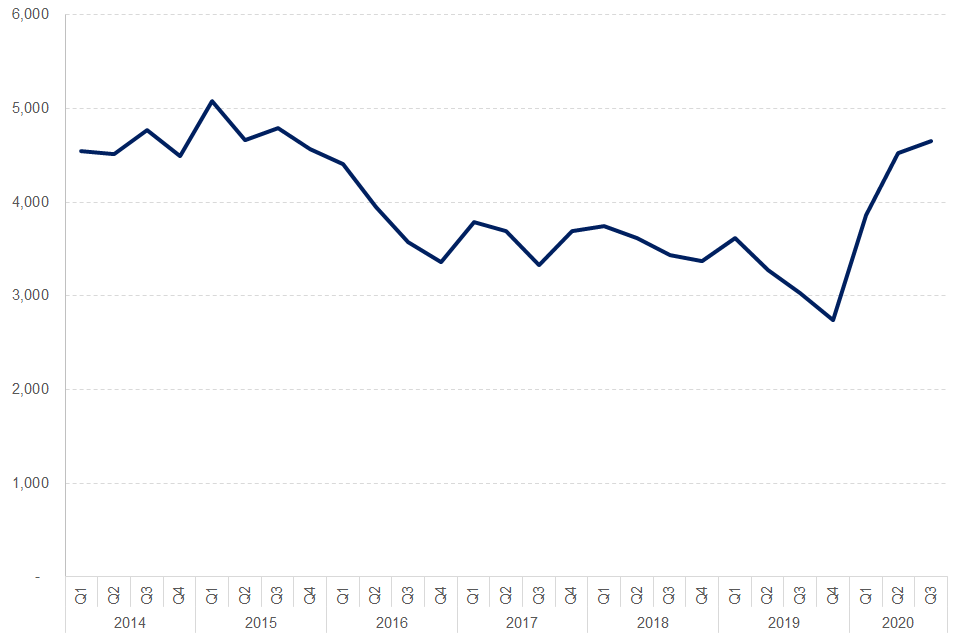
!!4
Vacated trials are trials which have been removed from the listing before the date of the trial. They are counted in the period the vacation happened rather than the date when they were due to be listed (e.g. as for effective, cracked and ineffective estimates). There were 4,656 vacated trials in Q3 2020, up 54% on the previous year and 3% on the previous quarter.
Guilty plea rates
It is likely that the guilty plea rate increase is caused by the restricted ability of courts to progress jury trials (e.g. not guilty cases) as part of the COVID-19 response. However, given the reduction in the volume of defendants dealt with and enforced changes to the operation and prioritisation of the courts, it is difficult to draw conclusions from this.
For defendants dealt with in trial cases at the Crown Court, the guilty plea rate [footnote 8] in Q3 2020 (79%) has increased markedly compared to Q3 2019 (69%). The majority of those entering a guilty plea do so prior to trial (65% in Q3 2020).
In Q3 2020, only 8% of all defendants dealt with at the Crown Court pleaded not guilty. This represents an 11 percentage point fall on Q3 2019, with a higher proportion of defendants dealt with entering a guilty plea following the suspension of jury trials and subsequent impacts of the COVID-19 response.
Average waiting and hearing time at the Crown Court
The median average waiting time [footnote 9] for defendants dealt with at the Crown Court was 6.9 weeks in Q3 2020. This represents an increase from 5.1 weeks in Q3 2019 but a fall from 7.3 weeks in Q2 2020.
A rise in median waiting time can be seen in trial cases where a guilty plea was entered, increasing from 5.1 in Q3 2019 to 8.0 weeks in Q3 2020.
Waiting times for appeal cases more than doubled from 6.4 in Q3 2019 to 13.9 weeks in Q3 2020. As more cases are disposed of at the Crown Court following the COVID-19 response it is expected that waiting time figures will begin to increase. The volume of defendants dealt with in appeal cases more than doubled since the last quarter, from 459 to 1,323.
Average hearing time at the Crown Court
The median hearing time [footnote 10] for trial cases where a not guilty plea was entered, has increased over the year to Q3 2020, up 12% on Q3 2019, from 11.1 to 12.4 hours. This is down on the series peak seen in Q2 2020 (15.0 hours), but volumes remain well below pre-COVID levels, down 66% from 2,830 in Q3 2019 to 965 in Q3 2020.
4. Timeliness
Timeliness at both the magistrates’ courts and Crown Court increased, with cases spending longer ‘at court’
The time from offence to completion at the magistrates’ court increased by 25%, from 160 days in Q3 2019 to 199 days in Q3 2020. At the Crown Court, the time from receipt to completion increased by 20%, from 95 days in Q3 2019 to 114 days in Q3 2020.
The COVID-19 pandemic has caused MoJ to have to change its data gathering, access and release practices, focusing efforts on priority analysis and statistics. Our statement explains this further. Of particular note, we temporarily paused access to the Police National Computer earlier this year, to minimise non-essential travel by our analysts.
As a result, and in line with guidance from the Office for Statistics Regulation, the decision has been made to delay the publication of all linked end-to-end criminal court timeliness data in this publication. As highlighted above, due to the COVID-19 pandemic, it has not been possible to produce linked end-to-end criminal court timeliness estimates for Q1 to Q3 2020. Data to the end of December 2019 remains the latest available estimates.
However, we have sought to best meet user demands and have included separate (‘unlinked’) timeliness estimates for magistrates’ courts and Crown Court.
-
The magistrates’ court data replicates the existing timeliness series and we have been able to update tables T1 – T3. The data provides estimates of the average duration from offence to completion at the magistrates’ courts.
-
The Crown Court data does not replicate existing timeliness series and it is published as ‘experimental statistics’ while we continue to develop the linked timeliness series. The data provides estimates of the average duration from receipt to completion at the Crown Court.
Magistrates’ court timeliness
Timeliness at the magistrates’ courts measures the time from an offence being committed through key stages of the criminal justice system including charge, first listing at the magistrates’ court and subsequent completion at court.
The median duration from offence to completion of defendants dealt with at the magistrates’ courts (excluding those sent to Crown Court) has increased by 24%, from 160 days in Q3 2019 to 199 days in Q3 2020, a series high.
Increases in overall median timeliness can be seen across all case types to varying degrees, with marked increases seen for defendants in indictable (55%) and triable-either-way cases (90%).
The increases can be seen across all timeliness stages both ‘pre-court’ and ‘at court’.
-
‘Pre-court’ time continued to increase, with the duration from ‘offence to charge’ continuing increases broadly seen since 2010, up 5% on the previous year (from 115 to 121 days). The median time from ‘charge to first listing’ also increased, up 20% on the previous year (from 30 to 36 days), but fell back from the series high seen in Q2 2020 (40 days).
-
‘At court’ median durations remain stable at 0 (e.g. first listing and completion occur on the same day), due to the proportion of summary cases completing. However, the overall mean for all cases has more than doubled (155%) from 19 days in Q3 2019 to 48 days in Q3 2020 – a series peak.
Similarly, defendants completing at the magistrates’ courts required more hearings on average to reach an outcome in Q3 2020 compared to the previous year, up by 45% (from 1.4 in Q3 2019 to 2.1 in Q3 2020). Related to this, the percentage of defendants who completed at first listing has fallen sharply, down 20 percentage points to a series low of 55%.
Figure 5: Average number of days from offence to completion for cases completing at the magistrates’ courts only by stage, Q2 2010 – Q3 2020 (Source: Table T3)
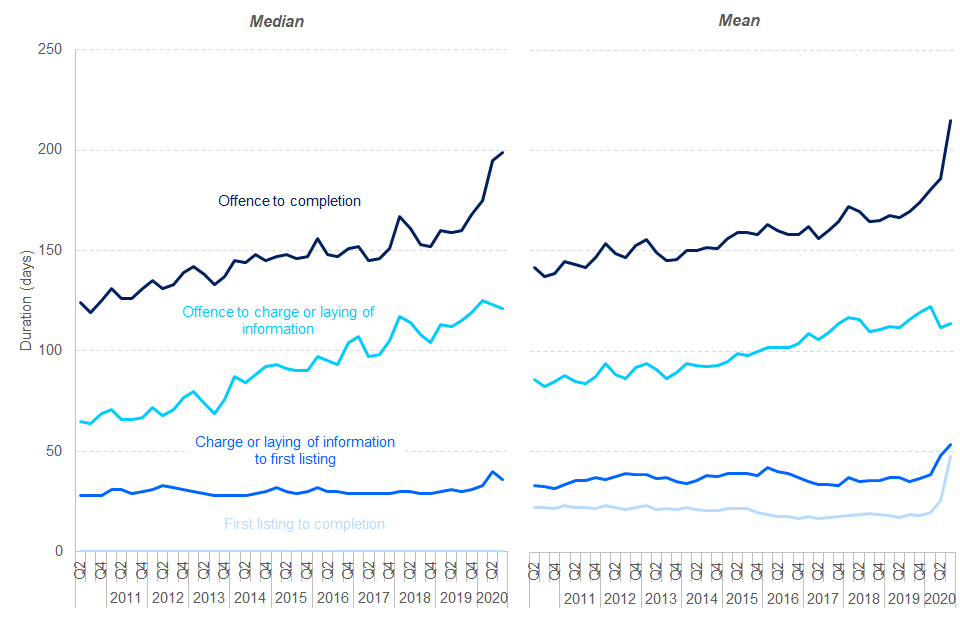
!!5
Crown Court timeliness - experimental statistics
Timeliness at the Crown Court is measured from the point of a case entering a Crown Court, reaching a main hearing and then completion at court. This data series remains in development and as such it is considered ‘experimental statistics’. Data presented here is not produced on the same basis as previously published linked end-to-end timeliness data which are available to Q4 2019 (see Tables T4 – T7).
The median duration from case entry to completion for defendants dealt with at the Crown Court has increased by 20%, up from 95 days in Q3 2019 to 114 days in Q3 2020.
Increases can be seen in the time from receipt to main hearing for all cases, up 18% from 40 days in Q3 2019 to 47 days in Q3 2020 – this follows a sharp increase in Q2 2020 (54 days). Whereas the median time from main hearing to completion fell, down 38% from 8 days in Q3 2019 to 5 days in Q3 2020.
The increase in overall timeliness at the Crown Court can be seen in both trial and sentence cases.
Changes to the makeup of trial cases completing at the Crown Court has impacted the timeliness estimates. In Q3 2020, only 8% of all defendants dealt with at the Crown Court pleaded not guilty. This represents an 11 percentage point fall on Q3 2019, with a higher proportion of defendants dealt with entering a guilty plea following the suspension of jury trials and subsequent impacts of the COVID-19 response.
-
For trial cases where a guilty plea was entered, the median duration from receipt to completion at the Crown Court increased by 34% from 108 days in Q3 2019 to 145 days in Q3 2020. A marked increase can be seen in the time from receipt to main hearing, up 51% to 56 days in Q3 2020. Whereas the time from main hearing completion increased only slightly on the previous year (from 28 days to 29 days).
-
For trial cases where a not guilty plea was entered, the median duration from receipt to completion at the Crown Court increased by 35% from 223 days in Q3 2019 to 302 days in Q3 2020. Similar annual increases can be seen in both timeliness stages, 15% from receipt to main hearing (from 176 to 203 days) and 13% from main hearing to completion (24 days to 27 days).
Figure 6: Median duration from receipt to completion at the Crown Court by case type, Q1 2014 - Q3 2020 (Source: Table E1)
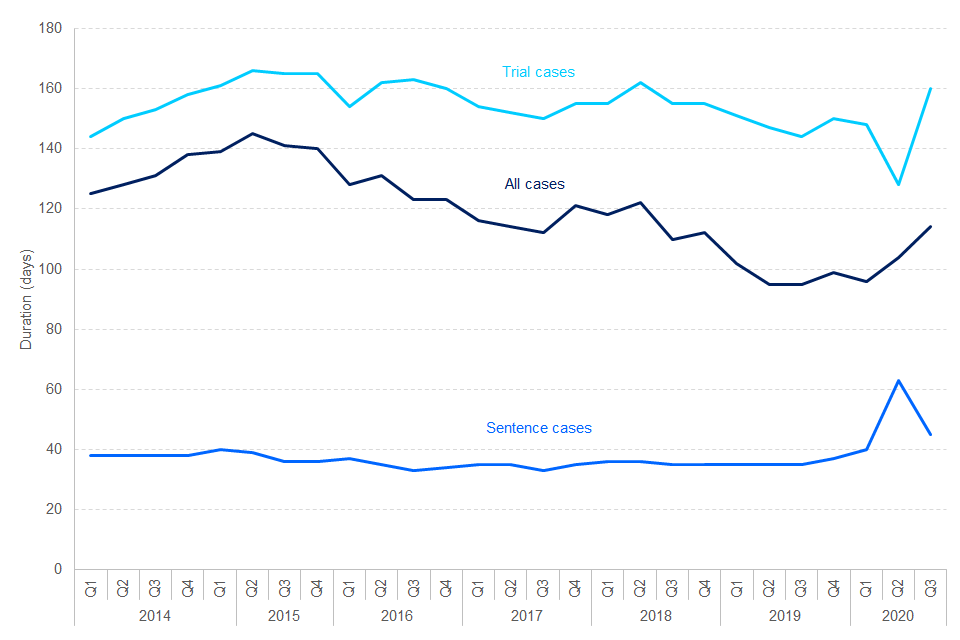
!!6
5. Enforcement of financial impositions
Total financial impositions increased on series lows in Q2 2020, but remain well below pre-COVID levels.
Total financial impositions in Q3 2020 rose to £94m from £56m in Q2 2020 but remain 35% lower than Q3 2019. The total value of outstanding financial impositions remained at £1.21 billion in Q3 2020 – stable over the last year.
Figure 7: HMCTS management information: Financial impositions by imposition type, England and Wales, Q2 2011 – Q3 2020 (Source: Table A2)
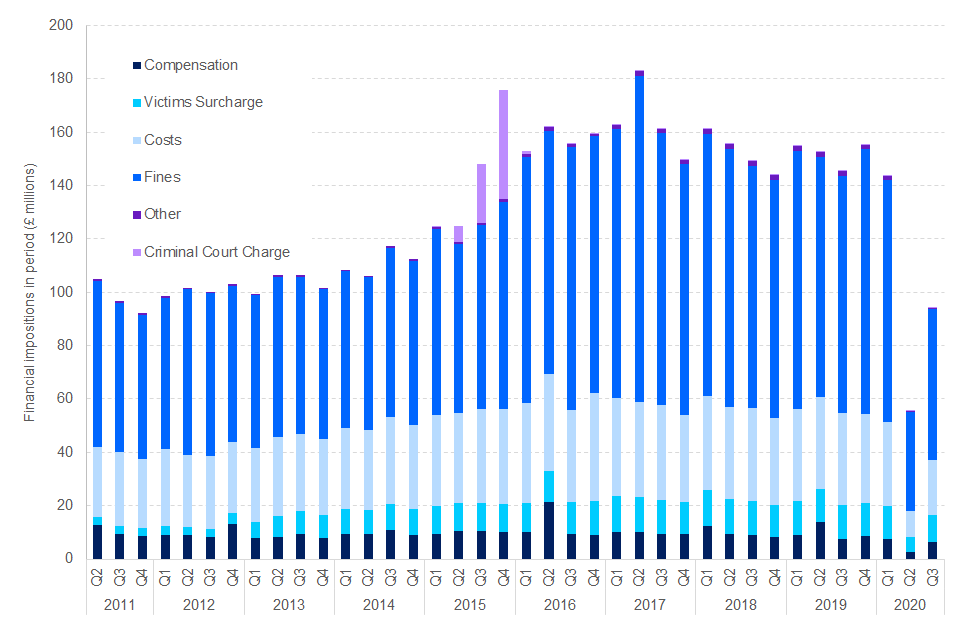
!!7
Financial impositions and amounts paid by imposition type
Following the continued impacts of the COVID-19 response the overall value of impositions fell by around £51.3m on Q3 2019, with falls against all imposition types. The majority of this is largely due to decreases in fines, where the value of fines imposed fell by £32.4m, down 36% compared with Q3 2019.
Outstanding financial impositions
In Q3 2020, the total value of financial impositions outstanding in England and Wales was £1.21 billion, up 3% on Q3 2019.
The amount of outstanding financial impositions has doubled since the start of 2015 (£571m). A change in policy regarding the collection of financial impositions is partially behind this cumulative increase – unpaid accounts are no longer routinely closed and therefore, more outstanding impositions are carried over from previous periods.
6. Experimental Statistics – language interpreter and translation services
The number of completed language service requests increased from a series low in the previous quarter and the success rate remained stable.
There were 33,143 completed requests in Q3 2020, up sharply from a series low in Q2 2020. The success rate for requests in Q3 2020 was 98%, stable with the previous year.
Completed service requests
There were 33,143 completed requests in Q3 2020, up sharply from a series low in the previous quarter (6,775) but remaining below volumes from the previous year (42,637).
Figure 8: Number of completed language service requests and overall success rate, Q1 2013 – Q3 2020 (Source: Table L1)

!!8
Success rate
The overall success rate of requests was 98% in Q3 2020, similar to rates seen since 2017. The increases in cancellations seen in Q2 2020 (34%) have fallen back closer to pre-COVID proportions (22% in Q3 2020).
Complaints and complaint rate
Unlike completed service requests, the number of complaints in Q3 2020 (45) has continued to decrease markedly. This represents a 91% decrease on volumes of complaints seen in Q3 2019 (507) and the overall complaint rate has fallen below 1%.
‘Off-contract’ requests
The number of ‘off-contract’ requests in Q3 2020 increased sharply on lows seen in Q2 2020, from 74 to 334 requests. Levels remains 57% below those seen in Q3 2019 (778).
The reduction in overall volumes of language service requests and complaints, as a consequence of the restrictions on court activity imposed during the COVID-19 pandemic response make it difficult to draw any firm conclusions regarding the observed trends.
7. Further information on criminal courts data
The latest data presented in this publication are provisional. Final data for each calendar year is published in June, following further data cleaning and the incorporation of additional cases not available in our original extracts.
Accompanying files
As well as the bulletin, the following products are published as part of this release:
-
Two technical guides providing background information and standalone quality guide.
-
A set of overview tables, covering each section of this bulletin.
-
Pivot tools and underlying data which feature further breakdowns of published data.
National Statistics status
National Statistics status means that official statistics meet the highest standards of trustworthiness, quality and public value. This bulletin recently underwent a compliance check with the Office for Statistics Regulation and retained its National Statistics status in January 2019 [footnote 11]. All official statistics should comply with all aspects of the Code of Practice for Statistics. They are awarded National Statistics status following an assessment by the Authority’s regulatory arm which considers whether the statistics meet the highest standards of Code compliance, including the value they add to public decisions and debate. It is the Ministry of Justice’s responsibility to maintain compliance with the standards expected for National Statistics. If we become concerned about whether these statistics are still meeting the appropriate standards, we will discuss any concerns with the Authority promptly. National Statistics status can be removed at any point when the highest standards are not maintained, and reinstated when standards are restored.
Experimental Statistics status
Experimental statistics are produced under the remit of the Code of Practice for Statistics. They are also produced impartially and are free from political influence [footnote 12].
Future publications
Our statisticians regularly review the content of publications. Development of new and improved statistical outputs is usually dependent on reallocating existing resources. As part of our continual review and prioritisation, we welcome user feedback on existing outputs including content, breadth, frequency and methodology. Please send any comments you have on this publication including suggestions for further developments or reductions in content to the contacts listed below.
Contact
Press enquiries should be directed to the Ministry of Justice press office:
Tel: 020 3334 3536
Email: newsdesk@justice.gsi.gov.uk
Other enquiries about these statistics should be directed to the Justice Statistics Analytical Services division of the Ministry of Justice:
Damon Wingfield, Responsible Statistician and Head of Criminal Justice System Statistics
Ministry of Justice, 3rd Floor, 10 South Colonnade, London, E14 4PU
Email: statistics.enquiries@justice.gsi.gov.uk
Next update: 25th March 2021
URL: https://www.gov.uk/government/collections/criminal-court-statistics
© Crown copyright Produced by the Ministry of Justice
Alternative formats are available on request from statistics.enquiries@justice.gsi.gov.uk
-
https://www.gov.uk/guidance/hmcts-weekly-operational-summary-on-courts-and-tribunals-during-coronavirus-covid-19-outbreak ↩
-
https://www.judiciary.uk/announcements/jury-trial-sites-4/ ↩
-
https://www.gov.uk/government/news/common-platform-system-tested-in-criminal-courts ↩
-
https://www.gov.uk/government/news/more-face-to-face-hearings-as-courts-reopen ↩
-
https://www.judiciary.uk/announcements/review-of-court-arrangements-due-to-covid-19-message-from-the-lord-chief-justice/ ↩
-
https://www.judiciary.uk/announcements/jury-trial-sites-4/ ↩
-
https://www.gov.uk/guidance/courts-and-tribunals-tracker-list-during-coronavirus-outbreak ↩
-
Guilty plea rate is the number of defendants pleading guilty to all counts as a proportion of those with a plea. ↩
-
The waiting time is the duration between a case being sent to the Crown Court and the first main hearing. ↩
-
The hearing time is the time a case spends being heard in the Crown Court, including preliminary hearings, main hearings, and hearings where a sentence is given to a defendant. ↩
-
https://www.statisticsauthority.gov.uk/correspondence/compliance-check-on-court-statistics/ ↩
-
https://www.statisticsauthority.gov.uk/monitoring-and-assessment/code-of-practice/ ↩
